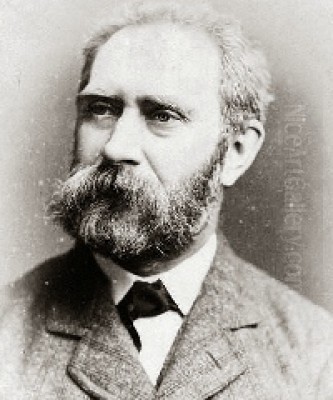
Edwin Longsden Long RA (1829–1891) stands as a significant figure in the landscape of nineteenth-century British art. A painter celebrated in his time for his large-scale historical, biblical, and Orientalist scenes, Long captivated the Victorian public with his meticulous detail, dramatic narratives, and evocative reconstructions of the ancient world. Though his fame waned with the rise of modernism, recent decades have seen a renewed appreciation for his technical skill and his work's complex reflection of Victorian society's interests and attitudes.
Early Life and Artistic Awakening
Edwin Long was born in Bath, Somerset, in 1829. His father, James Long, was a hairdresser, and initially, young Edwin was expected to follow in the family trade. However, from an early age, Long displayed a strong inclination towards art, sketching and drawing whenever possible. This burgeoning passion eventually overcame familial expectations, setting him on a path toward a professional artistic career, a common narrative for many artists of the era whose talents diverged from their intended paths.
His formal artistic education began not in the prestigious Royal Academy Schools, but through dedicated self-study. He spent considerable time at the British Museum in London, immersing himself in its vast collections, particularly the Egyptian and Assyrian antiquities. These artifacts would later become crucial references for the detailed historical reconstructions that defined his mature work. This period of independent learning honed his observational skills and deepened his fascination with the ancient past.
Following his studies at the British Museum, Long sought more structured training. He attended Leigh's Academy in Newman Street, London, a well-regarded art school run by James Mathews Leigh. This institution was a stepping stone for many aspiring artists, including future luminaries like Frederic Leighton and John Everett Millais, placing Long within an emerging generation of talented painters. Subsequently, Long enrolled in the Royal Academy Schools, further refining his technical abilities within the heart of the British art establishment.
The Influence of Spain and John Phillip
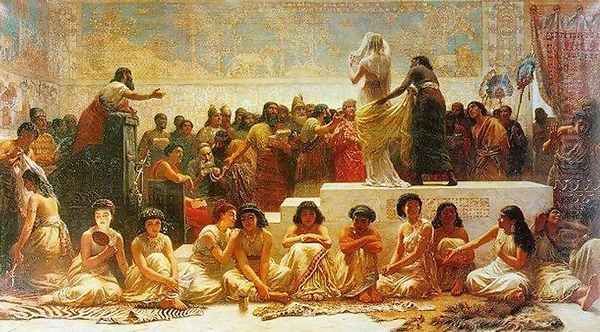
A pivotal moment in Long's early career was his encounter with the established Scottish painter John Phillip RA. Phillip, known for his vibrant depictions of Spanish life, became a mentor figure to Long. Recognizing the younger artist's potential, Phillip encouraged Long to travel and broaden his artistic horizons. In 1857, Long accompanied Phillip on a journey to Spain, an experience that profoundly shaped his artistic development.
In Spain, Long was deeply impressed by the works of the Spanish Golden Age masters, particularly Diego Velázquez and Bartolomé Esteban Murillo. He studied their techniques, their handling of light and shadow, their compositional strategies, and their ability to convey narrative and character. The influence of Velázquez's realism and Murillo's treatment of religious and genre subjects can be discerned in Long's subsequent work. This trip marked a shift away from his earlier focus on portraiture towards more ambitious historical and genre scenes, initially often with Spanish themes.
John Phillip's influence extended beyond mere travel companionship. His own success with colourful, anecdotal scenes of foreign life likely encouraged Long to explore similar avenues, albeit eventually shifting his geographical focus from Spain to the ancient Near East. Phillip's robust style and engagement with everyday life in a foreign setting provided a model for Long as he developed his own artistic voice.
Journeys East: Embracing Orientalism
While Spain provided initial inspiration, it was Long's later travels to the Middle East that truly defined his mature style and subject matter. In 1874, he journeyed to Egypt and Syria. This direct encounter with the landscapes, cultures, and archaeological sites of the Near East ignited his imagination and provided a wealth of authentic material for his paintings. He was fascinated by the remnants of ancient civilizations and the contemporary life that existed alongside them.
This period coincided with a surge of European interest in the "Orient," fueled by colonial expansion, archaeological discoveries, and romantic notions of exotic lands. Long became a prominent exponent of Orientalism in British art, specializing in reconstructions of ancient Egyptian, Babylonian, and biblical life. Unlike some Orientalist painters who focused on contemporary scenes of bazaars and harems, Long primarily directed his gaze towards the distant past, using archaeological findings to lend an air of authenticity to his grand historical narratives.
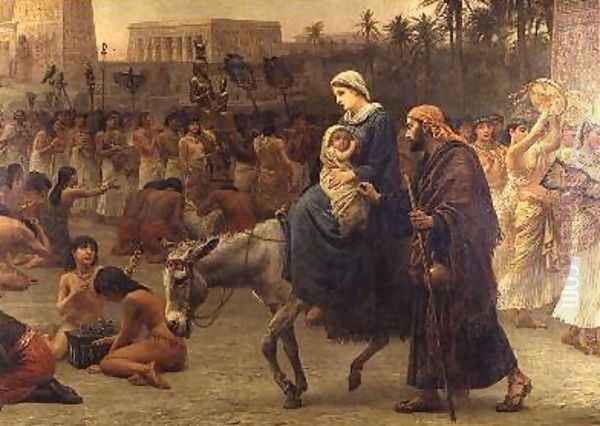
His time spent studying artifacts in the British Museum now paid dividends, allowing him to incorporate specific details of dress, architecture, and objects into his canvases. This commitment to perceived historical accuracy was a key element of his appeal to the Victorian audience, who valued art that was both visually impressive and seemingly educational. His works offered viewers a vivid, albeit interpreted, glimpse into worlds described in the Bible and classical texts.
Major Works and Defining Themes
Edwin Long's reputation rests largely on a series of ambitious, large-scale paintings depicting scenes from ancient history and the Bible. Among his most famous and impactful works is The Babylonian Marriage Market, exhibited at the Royal Academy in 1875. Based on a passage in Herodotus's Histories, the painting depicts a supposed ancient Babylonian custom where women were auctioned off for marriage. The work was a sensation, admired for its detailed rendering of figures and costumes, its complex composition, and its dramatic subject matter.
The Babylonian Marriage Market achieved enormous popularity and commanded a record price for a work by a living artist at the time. Its success cemented Long's position as a leading historical painter. The painting showcases his characteristic style: a crowded stage-like setting, meticulous attention to archaeological detail (drawing on Assyrian reliefs), a rich colour palette, and a narrative that blends historical reconstruction with Victorian sensibilities about gender and commerce. While presented as historical fact based on Herodotus, the scene also tapped into contemporary debates about women's roles and the marriage market in Victorian society itself.
Another significant work is Vashti Refusing the King's Call (1879), depicting the biblical story from the Book of Esther where Queen Vashti defies her husband, King Ahasuerus. This painting, like The Babylonian Marriage Market, features a strong female figure at the center of a dramatic historical narrative, rendered with Long's typical attention to detail and grand scale. It further explored themes of power, defiance, and the status of women in ancient societies, resonating with Victorian audiences interested in biblical stories and historical drama.
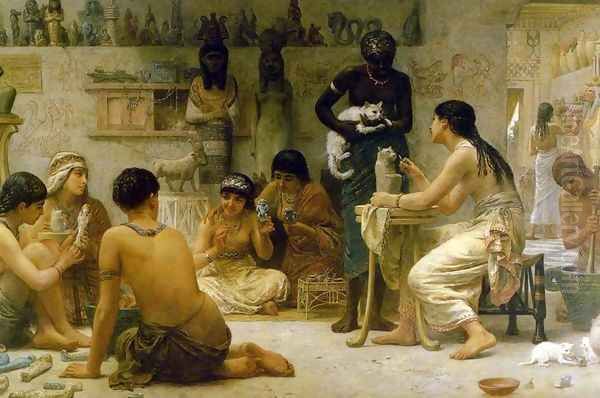
Other notable works include Anno Domini (also known as The Flight into Egypt, 1883), The Gods and Their Makers (1878), which depicted Egyptian artisans crafting idols, offering a subtle critique of idolatry, and An Egyptian Feast (1877), showcasing his ability to recreate scenes of daily life in antiquity. These paintings consistently demonstrate Long's commitment to historical research, his skill in managing complex multi-figure compositions, and his flair for dramatic storytelling on a grand scale. His biblical scenes aimed for a sense of historical realism, placing familiar stories within meticulously researched settings, rather than focusing purely on devotional aspects, aligning with a broader Victorian trend of historicizing religious narratives.
Artistic Style and Technique
Edwin Long's artistic style is characterized by its academic precision, meticulous detail, and narrative clarity. He worked primarily in oils on large canvases, suitable for the grand historical and biblical themes he favoured. His drawing was accurate and assured, defining figures and architectural elements with clarity. He paid considerable attention to texture, rendering fabrics, flesh, stone, and metal with a high degree of finish.
His use of colour was typically rich and varied, contributing to the exotic and dramatic atmosphere of his scenes. He employed strong lighting effects, often using chiaroscuro to highlight key figures or moments within the narrative, enhancing the theatrical quality of his compositions. The compositions themselves were carefully constructed, often arranged horizontally like a frieze or a stage, allowing the viewer to read the narrative across the canvas. He skillfully managed large groups of figures, differentiating individuals while maintaining overall compositional coherence.
A defining feature of Long's work was his emphasis on archaeological accuracy, or at least the appearance of it. He diligently researched historical costumes, architecture, and artifacts, drawing heavily on museum collections and published archaeological reports. This gave his paintings an air of authenticity that appealed greatly to the Victorian public's fascination with history and scientific discovery. While modern scholarship might question the absolute accuracy of some details, his effort to ground his imaginative reconstructions in tangible evidence was central to his method and appeal.
In his approach to historical reconstruction, Long can be compared to contemporaries like the Dutch-born, British-based Sir Lawrence Alma-Tadema. Both artists specialized in detailed depictions of antiquity, but Alma-Tadema often focused on more intimate, idyllic scenes of Roman or Greek domestic life, emphasizing texture and light, whereas Long tended towards larger, more dramatic narratives often set in the Near East. Another point of comparison is the French Orientalist Jean-Léon Gérôme, who also created highly detailed historical and ethnographic scenes, sharing Long's interest in meticulous rendering and dramatic effect.
The Royal Academy and Professional Success
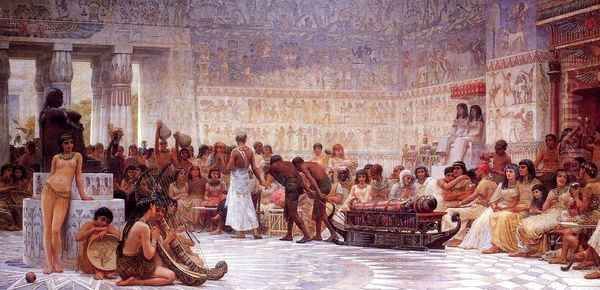
Edwin Long achieved significant professional recognition during his lifetime. His success was marked by his progression through the ranks of the Royal Academy of Arts, the most prestigious art institution in Britain. He was elected an Associate of the Royal Academy (ARA) in 1870 and achieved full Academician status (RA) in 1881. Election to the RA signified entry into the highest echelon of the British art world, bringing prestige and enhanced exhibition opportunities.
His paintings were consistently popular at the Royal Academy's annual exhibitions, often drawing large crowds. Works like The Babylonian Marriage Market were not only critical successes but also immense commercial triumphs. He commanded high prices for his major works, reflecting the strong market demand for his particular brand of historical and Orientalist painting among wealthy Victorian collectors. This commercial success allowed him to live comfortably and maintain a large studio.
Beyond his large narrative paintings, Long was also an accomplished portrait painter, although this aspect of his work is less famous today. He painted portraits of prominent figures, including society figures, fellow artists, and patrons like Baroness Burdett-Coutts and Henry Irving. Portraiture provided a steady source of income throughout his career, complementing his more ambitious and time-consuming historical projects.
Contemporaries and the Victorian Art World
Edwin Long worked during a vibrant and diverse period in British art history. The Victorian era saw numerous artistic movements and styles flourish concurrently. Long's career unfolded alongside the later stages of the Pre-Raphaelite Brotherhood, represented by figures like William Holman Hunt and Dante Gabriel Rossetti, who also tackled biblical and historical themes but with a different stylistic and symbolic intensity.
He was a contemporary of the great figures of High Victorian academic painting, such as Frederic Leighton and Edward Poynter, who shared his interest in classical and historical subjects and large-scale compositions, often emphasizing idealized forms and noble themes. As mentioned, Sir Lawrence Alma-Tadema was another key contemporary specializing in meticulously detailed scenes of antiquity.
The broader art scene also included narrative painters focusing on modern life, like William Powell Frith, social realists like Luke Fildes and Hubert von Herkomer, and artists associated with the Aesthetic Movement, such as James McNeill Whistler (though Whistler's artistic philosophy was vastly different from Long's). Animal painters like Briton Rivière also enjoyed great popularity. French artists like Jean-Léon Gérôme and illustrators like Gustave Doré, known for his dramatic biblical illustrations, were also influential figures whose work resonated with similar themes or approaches seen in Long's art.
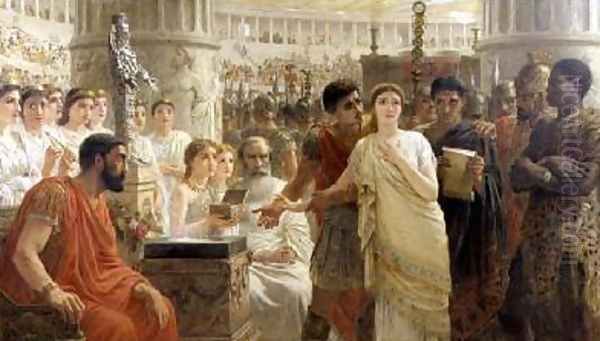
Long navigated this complex landscape successfully, carving out a distinct niche with his focus on the ancient Near East and his blend of archaeological detail and dramatic storytelling. He represented a mainstream, highly successful strand of Victorian academic art that catered to the public's appetite for narrative, historical instruction, and exotic spectacle.
Later Life, Death, and Shifting Legacy
Edwin Long enjoyed sustained success throughout the 1870s and 1880s. He continued to produce major works and exhibit regularly. However, his life was cut short unexpectedly. He died relatively suddenly from pneumonia following an attack of influenza at his home in Hampstead, London, on May 15, 1891, at the age of 61. His death occurred just two days after the death of the eminent portrait painter and President of the Royal Scottish Academy, Sir William Fettes Douglas.
After his death, his wife attempted to maintain his artistic legacy and capitalize on his remaining works. She oversaw the establishment of the Edwin Long Gallery on Old Bond Street, London, dedicated to exhibiting and selling his paintings. However, this venture was not a lasting success. Artistic tastes were already beginning to shift away from the detailed academic style that Long represented. The rise of Impressionism, Post-Impressionism, and other modern art movements in the late nineteenth and early twentieth centuries valued different aesthetic qualities – spontaneity, subjective expression, formal innovation – over historical narrative and meticulous finish.
Consequently, Long's reputation, like that of many successful Victorian academic painters, declined significantly during the first half of the twentieth century. His work was often dismissed as overly literal, theatrical, or simply illustrative, lacking the perceived depth or formal interest of modernist art. His paintings, once highly sought after, fell out of critical favour and commanded lower prices.
Re-evaluation and Modern Perspectives
Beginning in the latter half of the twentieth century, and accelerating in recent decades, there has been a significant reassessment of Victorian art, including the work of Edwin Long. Art historians and curators began to look beyond modernist prejudices and appreciate Victorian painting on its own terms, recognizing its technical skill, intellectual ambition, and cultural significance.
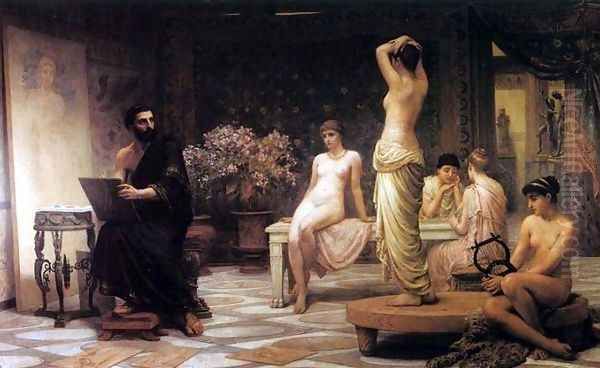
Long's work is now studied within the context of nineteenth-century historicism, the development of archaeology, and the complex phenomenon of Orientalism. Scholars analyze his paintings not just as artistic objects but as cultural documents that reveal Victorian attitudes towards history, religion, empire, gender, and the "Other." His meticulous reconstructions are valued as insights into how the Victorians visualized the past, informed by the scientific and archaeological knowledge available to them.
The study of Orientalism, particularly following Edward Said's influential critique, has brought renewed attention to Long's work, examining how his depictions of the Near East participated in constructing Western ideas about the Orient. While acknowledging the potential for stereotype and the problematic aspects of the colonial gaze inherent in much Orientalist art, contemporary analysis also recognizes the genuine fascination, research, and artistic effort involved in Long's creations. His depictions of strong female figures like Vashti have also attracted interest from feminist art historians.
This renewed scholarly interest has been accompanied by a revival in the art market. Long's major paintings, when they appear at auction, now command substantial prices once again, reflecting a renewed appreciation among collectors for his skill and the historical importance of his work. His paintings are held in major public collections, including the Royal Academy of Arts, the Victoria and Albert Museum, the British Museum, and numerous galleries worldwide, ensuring their continued visibility and study.
Conclusion
Edwin Longsden Long was a quintessential Victorian artist, achieving immense popularity through his mastery of historical and biblical narrative painting. His canvases, characterized by their grand scale, meticulous detail, archaeological research, and dramatic flair, transported viewers to the ancient worlds of Egypt, Babylon, and the Bible. Influenced by Spanish masters and his own travels in the Near East, he became a leading figure in the Orientalist movement within British art.
While his fame diminished in the era of modernism, his work has experienced a significant critical and commercial revival. Today, Edwin Long is recognized as a highly skilled academic painter whose work offers valuable insights into the artistic tastes, historical interests, and cultural attitudes of the Victorian era. His paintings remain compelling examples of nineteenth-century narrative art, admired for their technical accomplishment and their ambitious engagement with history and the exotic, securing his place as an important, if complex, figure in the history of British art.